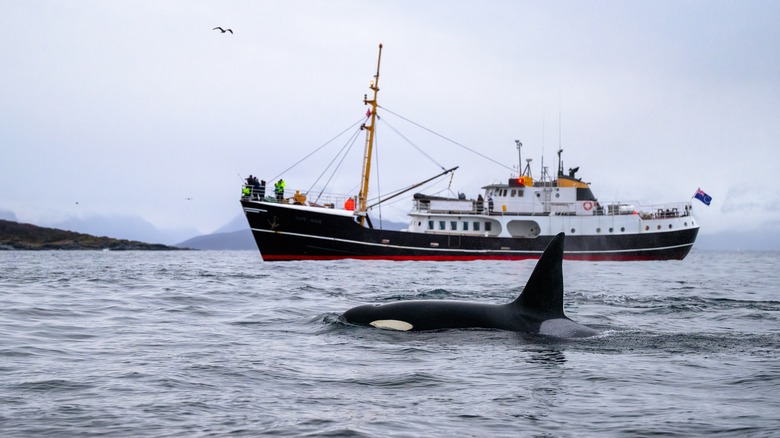Perhaps you’ve seen the unsettling viral TikToks of the North Sea. Usually soundtracked by a bass-boosted version of the sea shanty “Hoist the Colours,” these clips depict something that can only be described as the most horrifying sea in the world. Stuck out at sea oil rig workers drenched by waves the size of a building, cargo ships enduring Titanic-level submersion, and whirlpools that could obliterate Moby Dick are just some of the highlights. TikToks with the #northsea hashtag have garnered over 6.4 billion views and cemented the notion that the North Sea is, indeed, horrifying. But is it really?
To understand the reality of the North Sea, it’s essential to delve into its geographical, meteorological, and historical contexts. The North Sea is located in the greater Atlantic Ocean and covers an area of 220,000 square miles between Great Britain, Norway, Denmark, Germany, the Netherlands, Belgium, and France. Surprisingly, it’s known for its shallow depth, averaging 120 to 300 feet. However, some shallower areas are less than 100 feet, and some deeper areas exceed 1,000 feet.
Waves reach 65 feet, and occasional rogue waves go even higher. Water temperatures are notoriously cold, averaging 62 degrees Fahrenheit in the summer and 42 degrees in the winter. With a relatively medium size compared to other bodies of water, susceptibility to intense winds, and the influence of Atlantic currents, the North Sea is prone to rapid changes in weather conditions — creating a harsh environment for anyone daring enough to venture into its waters.
North Sea: Past, present, and future
@ukdestinations
The last clip will truly shock you 😳 Have you ever been out on the North Sea before? It is not only one of the most dangerous in the world but also the coldest (it has an average temperature of 17°C in summer and 6°C in winter) #northsea #ocean #explore #adventure #fyp
♬ Hoist the Colours – Bass Singers Version – Bobby Bass
Throughout history, the North Sea has been a crucial maritime route for trade, exploration, and warfare. Its waters have witnessed Viking voyages, pivotal naval battles in WWI and WWII, and even Roman exploration as early as 12 B.C. The seasickness-inducing conditions of the North Sea have tested sailors for centuries.
In recent years, the North Sea has become an economic hub, specifically for offshore renewable energy production, crude oil and natural gas, fishing, and maritime work like shipping, coastal protection, and, surprisingly, cruise tourism. While all these ventures present significant money-making opportunities, they alsso pose some obvious challenges for maintenance and operation crews.
TikTok’s deadly portrayal of the North Sea is not entirely exaggerated. In 1988, 167 people died after explosions aboard the Piper Alpha oil rig. In 1953, a storm on the North Sea killed 2,000 people on the coasts of the U.K., Belgium, and the Netherlands. In 2023, a collision of two cargo ships claimed the lives of five people. Unfortunately, there are many devastating cases like these. Despite being well-traversed, the North Sea is one of the most dangerous in the world.
However, thanks to modern technology and more stringent safety regulations, travel and work in the North Sea are safer today than in the past. Ships are better designed to handle rough waters, and systems are in place for weather forecasting, navigation, and emergency response. Every year, hundreds of thousands of ships make a (mostly) safe journey through the North Sea.
The real experience of the North Sea

Besides oil rigs and cargo ships, the North Sea is a 20,000-year-old ecosystem home to around 10 million seabirds, 230 species of fish, and an array of marine mammals. It has become one of the world’s most important fishing grounds — however, efforts to protect its environment from pollution, overfishing, and the effects of climate change are ongoing. The health of the North Sea is vital for all those biological residents and also for the human populations that rely on its resources.
The dramatic TikTok videos capturing the North Sea’s tempestuous nature don’t necessarily provide a complete picture. While it’s true that the sea can be incredibly rough, these conditions are not constant. Like any other maritime region, the North Sea experiences periods of calm, especially during July and August. The portrayal of the sea as perpetually horrifying is more a reflection of the human fascination with nature’s extremes than an accurate depiction of daily conditions.
You can, in fact, experience the North Sea firsthand instead of scrolling through TikToks from the comfort of your couch. Cruises through the North Sea offer a unique opportunity to explore the diverse coastlines of countries like Norway, the UK, Denmark, Germany, and the Netherlands. These cruises are usually scheduled for an average of two weeks, mainly in the warmer months (for smoother sailing and sunnier weather). Royal Caribbean, Hurtigruten Expeditions, and Cunard cruises cater to various preferences — from luxe to adventurous. Sail away, ye seafarer, and hoist the colors high!

